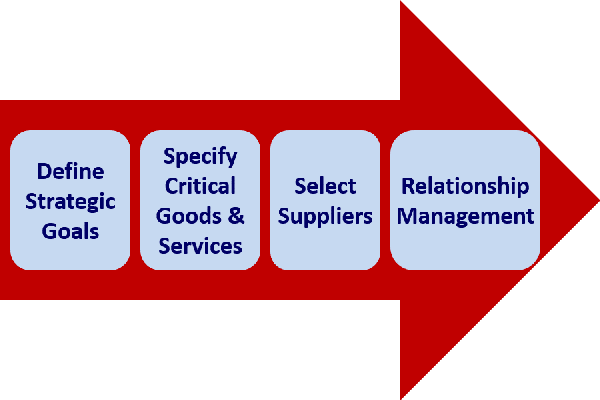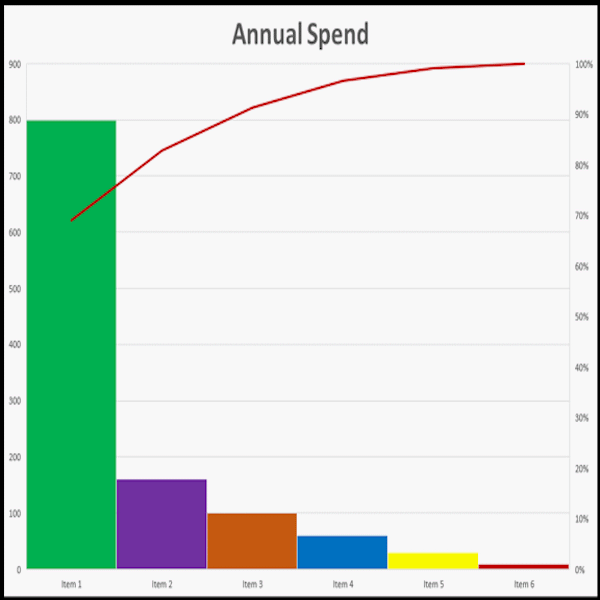By Mike Loughrin, CEO for Transformance Advisors
Two Steps
In our prior article, Putting Strategy into Strategic Sourcing, we identified a systematic process to secure critical goods and services in a manner which is aligned with the strategic objectives of the organization.
After you “define strategic goals,” you will need to “specify critical goods and services”. This can be accomplished in two steps:
- Identify all items which should be classified as critical
- Determine sourcing criteria for each critical item
Let’s explore these two steps.

Identify Critical Items
A Pareto analysis will identify those items which are critical goods and services because they are a large percentage of spending. The typical approach is to take annual usage multiplied by unit cost. The items whose cumulative value is 80% of total spend are classified as critical.
Additional items will also be critical and often reflect the need to support one or more strategic goals. For example, a strategic goal to reduce your carbon footprint will mean energy is critical and must be part of your strategic sourcing program.
This does not need to be a complex process. For most organizations, you will have:
- 1 core strategy
- 1 network strategy
- 3 to 5 strategic initiatives
- 2 to 4 social responsibility concerns
After assessing your spending and strategic goals, you may have 10 to 30 critical goods and services.

Determine Sourcing Criteria
The second step, for specifying critical goods and services, is to craft the sourcing criteria you want your procurement team to follow when selecting suppliers.
The criteria should be developed for each item. While many items will be the same, there could be nuances which require differences. For example, an ERP system must be able to support your plans for growth – in terms of customers, products, people, locations, and whatever. A raw material, with large annual spend, might be for a product line which is not expected to grow.
As with identifying the critical items, determining the sourcing criteria does not need to be complex. The chart on the right is the sample sourcing criteria for one critical good for one company.
When the sourcing criteria is complete, you are ready for the step 3 of the strategic sourcing process. It’s time for supplier selection.
| Sample Sourcing Criteria |
|---|
| Must provide high quality and on-time delivery to meet differentiation strategy |
| Prefer supplier, about our size, willing to collaborate on process improvement and new product development |
| Prefer regional supplier with short lead times |
| Prefer not to source from competitor, but OK is the supplier sells to our competitors |
| Must support our strategic initiative to grow revenue for products using this material |
| Must have carbon footprint reduction program as this material is a major source of greenhouse gas emissions |
Summary
A common error, when identifying critical goods and services, is to rely solely on annual cash expenditures. While cash is important, it is not the only criteria aligned with strategic goals. The goods and services included in your strategic sourcing program must include all items which are critical for achieving your strategic goals.
Once identified, you need to determine specific sourcing criteria for each item. These item specific criteria will be used in the next step of selecting suppliers.

Mike Loughrin is the CEO and Founder of Transformance Advisors. He also teaches for Louisiana State University Shreveport and is on the board of directors for the Association for Supply Chain Management Northern Colorado.
Mike brings exceptional experience in industry, consulting services, and education. He has directed several Lean Transformation programs and has helped organizations such as Levi Strauss, Warner Bros., Cabela’s, Constellation Brands, Lexmark, and Sweetheart Cup.
Keeping a commitment to a balanced life, Mike loves downhill skiing, bicycle rides, and hiking in the mountains. See one of his trails of the month at: Little Switzerland.
Global Sourcing
What is Strategic Sourcing?
Successful Supplier Selection
Putting Strategy into Sourcing
What is Supply Chain Management?
Subscribe to our newsletter
References
Understanding the Pareto Principle by Better Explained
Organizational Improvement Acronyms by Transformance Advisors
Organizational Improvement Definitions by Transformance Advisors

